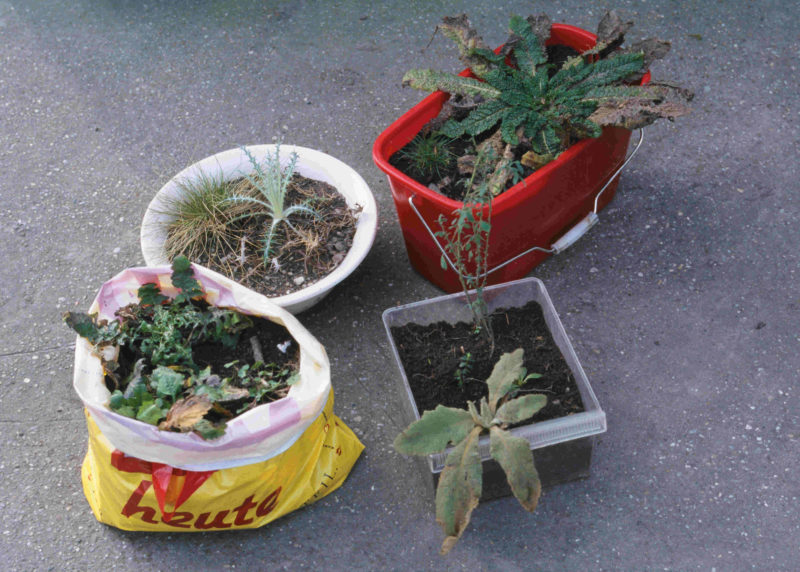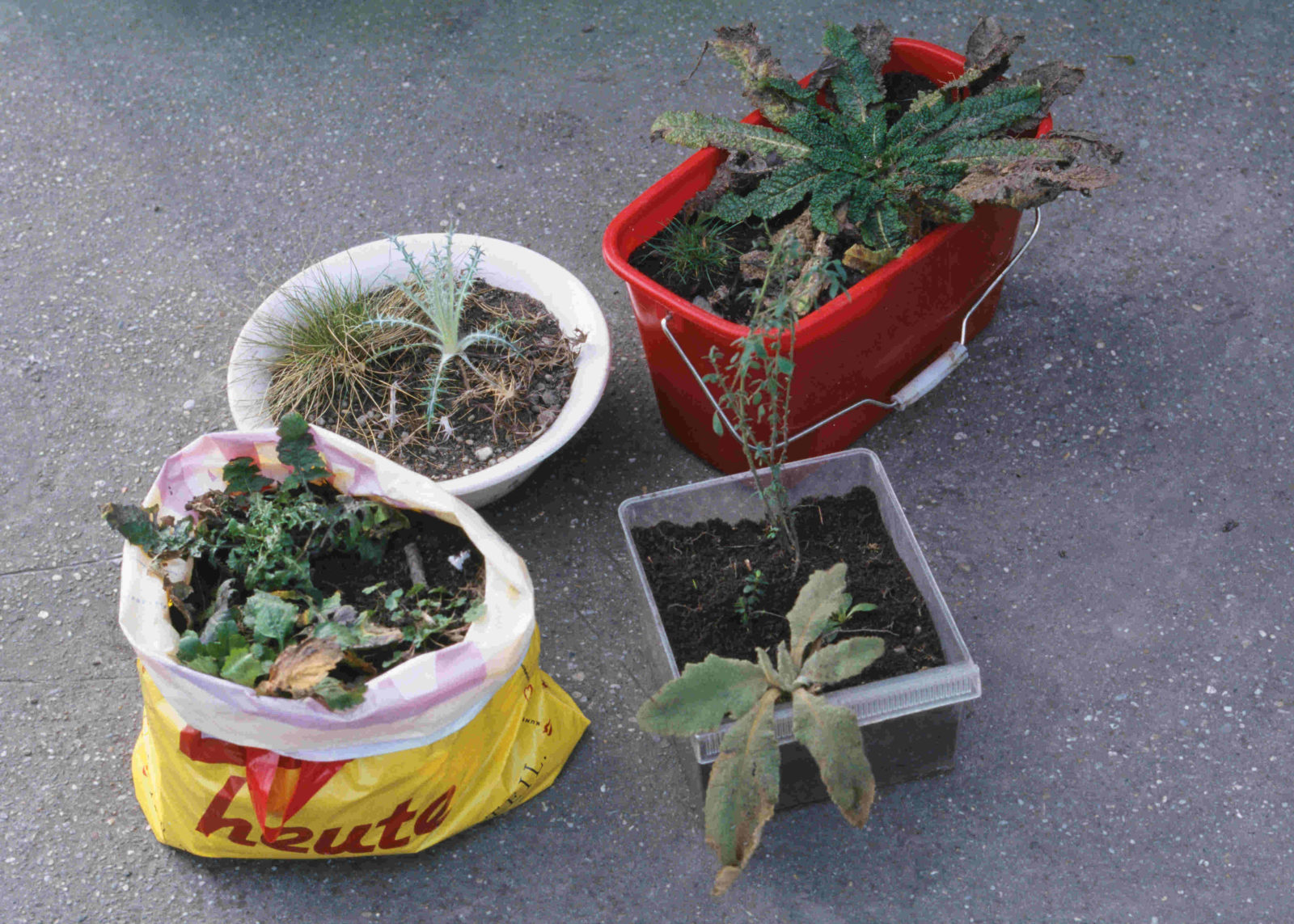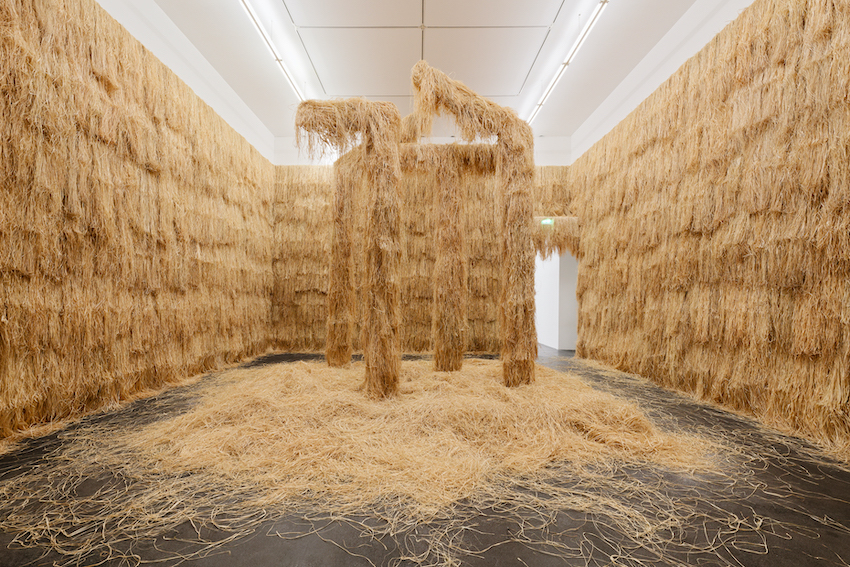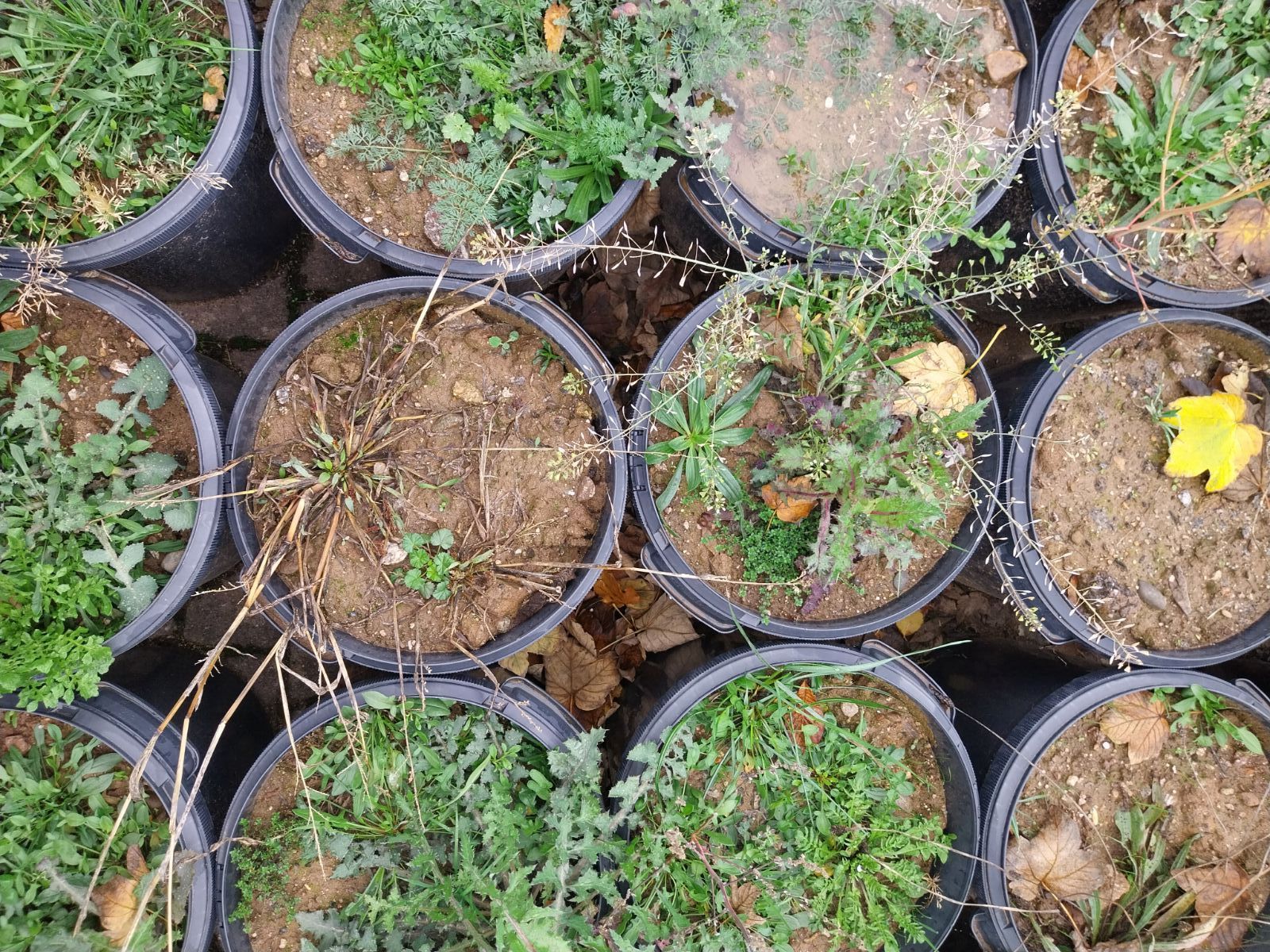april 5 – june 29, 2024
Lois Weinberger
Soil
solo
march 28 – june 29, 2024
les gens d’Uterpan (Franck Apertet)
Désorganigramme
> Scan QR code to enter the exhibition
> https://www.salleprincipale.com/artistes/les-gens-duterpan/

Lois Weinberger
Soil | exposition personnelle | 05 avril – 29 juin 2024
Pour cette nouvelle exposition personnelle de Lois Weinberger qui ferme un cycle de 10 ans d’activités de la galerie, nous avons demandé à deux personnalités du « champ de la nature » de commenter des œuvres.
Gilles Clément, poète, jardinier engagé… et Thierry Letellier, paysan de la montagne Limousine, ont répondu à cet exercice.
Gilles Clément — février 2024
Le sol
Ces trois photographies de la série ‘Stage’ montrent l’amplitude biologique des espèces frugales. Pas besoin d’un sol riche, survitaminé et bien arrosé pour installer ses racines et se développer. Un sol en béton suffit. Quelques plantes parviennent à se poser dessus et vivre. Les plus habiles, les plus modestes, les plus anciennes s’y installent sans difficulté.
Ce sont les bryophytes, le groupe des mousses.
Les mousses font partie de cet ensemble de plantes à la fois archaïques et performantes. Seraient-elles en avance sur toutes les autres espèces, celles qui demandent assistance sans pouvoir se contenter d’un maigre substrat et sans pouvoir survivre face aux aléas du changement climatique ?
Le béton n’est pas un riche territoire d’accueil mais il contient quelques sels minéraux utilisables par les végétaux. Il suffit d’un peu d’eau pour les dissoudre et en faire un aliment utile.
La grande performance de la mousse vient de sa propre structure. Elle n’a pas de racine. Elle se pose sur un sol et pompe son humidité enrichi d’éventuels minéraux. Si le sol sèche, elle se rétracte et se met en pause. Elle attend. Les autres meurent.
Sa reviviscence surviendra dès les premières pluies. Elle semble éternelle.
En demeurant sur place elle fabrique un sol organique à partir de ses propres déchets. Ce substrat va permettre aux espèces végétales plus exigeantes de s’installer. Une des photos montre la montée d’une tige de laitue sauvage qui profite sans doute de ces bonnes conditions d’accueil : un léger creux dans la dalle, réceptacle parfait pour un sol organique, rétention de l’humidité, tout est là. Et le béton verdit.
Pas partout. Il fabrique un paysage dont la profondeur s’accroît par les contrastes entre la matière minérale et le vert des plantes. Mais qui a fait ce paysage ? …
Difficile de donner une réponse mais une chose est sûre : le photographe l’a vu.
Tout le monde n’a pas ses yeux.
Avec les siècles le béton va s’enrichir. Sa couleur s’effacera derrière les apports de la chlorophylle. Sa structure semblera toujours présente à nos yeux…mais on la sait fragile.
Dans quelque temps le photographe nous montrera une forêt.
Thierry Letellier — février 2024
‘Untitled (Holding the Earth)’ 2010
Dans les imaginaires et représentations des peuples autochtones d’Amérique centrale et du sud, la ‘Terre mère’, devenue plus tard terre nourricière, est souvent dessinée, peinte, en image planète, ronde, belle et féconde, ou avec de très poétiques mises en scènes d’écosystèmes agro-forestiers ou agro-pastoraux. A la fin du vingtième siècle sont apparus, dans ces propositions, les dégâts de la civilisation humaine, industrielle et mercantile.
Lois Weinberger, dans cette œuvre photographique, ‘Untitled (Holding the Earth) 2010’, nous offre un versant occidental à ce narratif. Un homme, qui pourrait être un paysan, vu ses mains et sa chemise, porte contre son cœur, dans un geste de bienveillance et de protection, une brassée de terre noire. La couleur de cette terre nous dit qu’elle est particulièrement riche en matière organique, donc en micro-organismes du sol, en champignons et par là même, pleine de vie. C’est une terre riche, naturelle, qui porte en elle, les promesses du sol et des plantes qui vont pouvoir y prospérer.
Dans les années 1990, Lois Weinberger nous suggérait par certaines de ses œuvres, ‘Burning and Walking 1993-1997’, ‘Garden 1994’, que la nature était plus forte que le béton, l’asphalte ou le plastique. Qu’il suffisait de casser la pellicule inerte et mortifère pour que les différentes couches du sol et de l’atmosphère se reconnectent et redonnent ainsi leur chance aux formes de vie naturelle. Mousses, lichens, herbes puis arbustes bousculaient l’ordre minéral artificiel. L’organique réapparaissait et se multipliait.
Dans cette photographie, une quinzaine d’années plus tard, Lois Weinberger, en visionnaire, qu’il n’a jamais cessé d’être, nous dit avec émotion et radicalité, que nous devons prendre soin de notre terre et arrêter de massacrer notre trésor. Que nous devons rétablir le contact avec la terre et ses occupants non-humains en premier lieu. Il nous dit ce que nous savons tous. L’urbanisation sauvage de cette planète, l’agriculture intensive, la déforestation massive, aujourd’hui tout est en marche pour détruire nos sols, nos terres forestières, agricoles et nourricières.
Il nous suggère surtout de retrouver une intimité et un lien fusionnel avec la terre, comme nos ancêtres paysans européens, comme les agriculteurs cueilleurs de l’Amazonie il y a 10 000 ans, comme les communautés zapatistes d’aujourd’hui.
‘Storksbill, the life of plants’ 2011
Dans cette vidéo, ‘Storksbill, the life of plants’ 2011, Lois Weinberger nous fait plonger dans la profondeur du végétal, du paysage.
Nous sommes une abeille butinant une fleur d’Erodium Bec-de-cigogne ou un cétoine doré qui broute ses délicats pétales dans un jardin ensoleillé.
Au plus profond de la fleur on peut observer, ressentir les mouvements de la vie végétale.
Respiration circulation de la sève comme un battement de cœur, Lois Weinberger nous permet d’approcher la formidable énergie de vie que chaque plante porte en elle.
La majorité des végétaux est capable de produire de l’oxygène à partir du gaz carbonique, de s’auto-alimenter en énergie à partir des rayons solaires et bien-sûr de s’adapter à son environnement. On sait aussi que les plantes d’une même espèce ont la capacité de communiquer et de s’échanger des informations. Erodium ciconium est un géranium sauvage particulièrement vivace, résistant, rustique. Il prospère facilement le long des chemins sableux ou rocailleux. Là où il se plait il a même tendance à devenir un peu envahissant…
Ces images pleines de la vie poétique et esthétique des végétaux devraient nous inciter à réfléchir sur nos liens et nos rapports avec eux. A chaque fois que nous allons couper une fleur ou arracher une herbe que nous pensons ‘mauvaise’, gardons en mémoire cette formidable respiration que nous allons interrompre.
Lois Weinberger
Soil | solo exhibition | april 5 – june 29, 2024
For this new solo exhibition devoted to Lois Weinberger, which brings to a close a 10-year cycle of activities at the gallery, we have asked two personalities from the “field of nature” to comment on some of the artworks.
Gilles Clément, a poet and committed gardener, and Thierry Letellier, a farmer from the Montagne Limousine region, agreed to take part.
Gilles Clément — february 2024
The soil
These three photographs from the series titled ‘Stage’ show the biological amplitude of frugal species. They have no need for rich, well-watered soil loaded with vitamins to put down their roots and grow—a patch of concrete is enough. Some plants manage to settle here and thrive. The cleverest ones, the most modest ones and the oldest ones establish themselves easily. These are the bryophytes: the mosses.
Mosses belong to a set of plants that are both ancient and highly efficient. Are they more advanced than all other species, which require assistance and cannot cope with poor subsoil or survive when faced with the vagaries of climate change?
Climate is not a rich material to call home, but it does contain a few mineral salts that plants can use. All they need is a little water to dissolve them and make them into a useful nutrient.
The high performance of moss comes from its structure: it has no roots; instead, it sits on the ground and sucks up its moisture, perhaps enriched with minerals. If the ground dries out, the moss shrinks and takes a break. It waits while the other plants die.
It comes back to life as soon as it rains again. It seems to be eternal.
By staying in one place, it creates organic soil from its own waste. This subsoil allows other, more demanding plants to establish themselves. One of the photos shows a wild lettuce stalk growing, no doubt making the most of these favourable conditions: a slight hollow in the slab that forms a perfect receptacle for organic soil and is able to retain moisture: all the conditions are right, and the concrete turns green.
Not everywhere, though. It creates a landscape whose depth increases thanks to contrasts between the bare concrete and the green plants. But who made this landscape?
It’s hard to answer that question, but one thing is for certain: the photographer saw it.
Not everyone has his eyes.
Over the centuries, the concrete will become enriched. Its colour will vanish behind what chlorophyll brings. Its structure will always seem present to us…but we know how fragile it is.
In a while, the photographer will show us a forest.
Thierry Letellier — february 2024
‘Untitled (Holding the Earth)’ 2010
In the imaginations and representations of indigenous peoples of Central and South America, “Mother Earth” is often drawn or painted as a round, beautiful, fertile, planet-like image, or in highly poetic presentations of agricultural, pastoral or woodland ecosystems. At the end of the twentieth century, the damage caused by human industrial and mercantile civilisation began to appear within them.
In the photograph ‘Untitled (Holding the Earth)’, Lois Weinberger offers a western take on this narrative. A man, who could be a farmer given his hands and shirt, holds an armful of black soil against his heart, in a gesture of care and protection. The colour of the soil tells us that it is especially rich in micro-organisms and fungi and thus full of life. It’s a rich, natural soil that bears within it the promises of the plants that will be able to thrive there.
In the 1990s, some of Lois Weinberger’s artworks, including ‘Burning and Walking’ and ‘Garden’, suggested that nature was stronger than concrete, asphalt or plastic. That all we had to do was to break through that inert, dead layer for the different strata of the soil and the atmosphere to reconnect and give natural life forms a chance. Mosses, lichens, grasses and shrubs upset the artificial order of minerals. The organic reappeared and multiplied.
In this photograph, some fifteen years later, Lois Weinberger, always the visionary, told us, emotionally and radically, that we must take care of the Earth and stop destroying our precious resources. He said that we must first re-establish contact with the Earth and its non-human occupants. He told us what we all know. Rampant urban development, intensive agriculture, widespread deforestation…today everything is in the process of destroying our soil, our forests and our agricultural land.
He suggested above all that we should rediscover a form of intimacy and a vital connection with the Earth, like the European farmers who were our ancestors, like the hunter-gatherers of the Amazon 10,000 years ago, and like today’s Zapatista communities.
‘Storksbill, the life of plants’ 2011
In this video, ‘Storksbill’, Lois Weinberger takes us into the depths of the plant kingdom and of the landscape.
We are a bee visiting a common stork’s bill (Erodium ciconium) or a rosechafer grazing on its delicate petals in a sunny garden.
In the depths of the flower, we can observe and sense the movements of plant life.
The respiration and circulation of the sap is like a heartbeat; Lois Weinberger allows us to get close to the incredible vital energy that every plant bears within it.
Most plants are able to produce oxygen from carbon dioxide, to get their energy from sunshine, and of course to adapt to their environment. We also know that plants of the same species can communicate and exchange information. Erodium ciconium is a wild geranium, an especially resilient and hardy perennial. It thrives along sandy or stony paths, where it even tends to be a little invasive…
These images full of the poetic and aesthetic life of plants should prompt us to think about our connections and relationships with them. Every time we cut a flower or pull up a plant we think of as a ‘weed’, let’s remember the amazing respiration that we’re about to interrupt.



